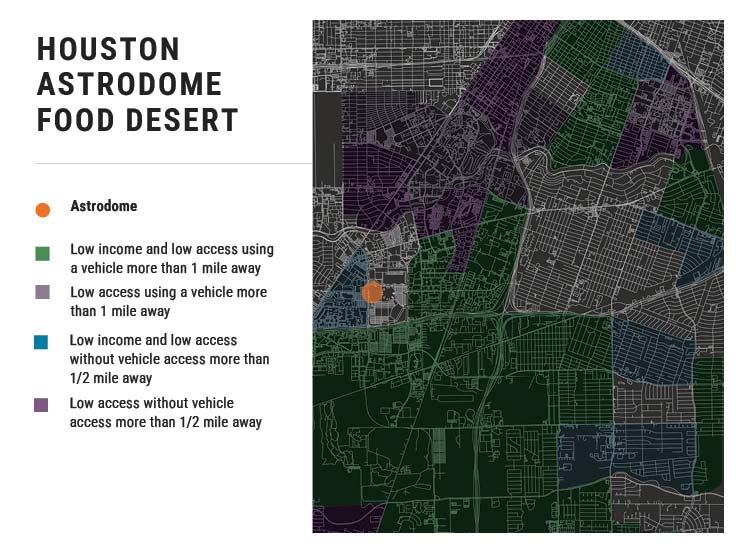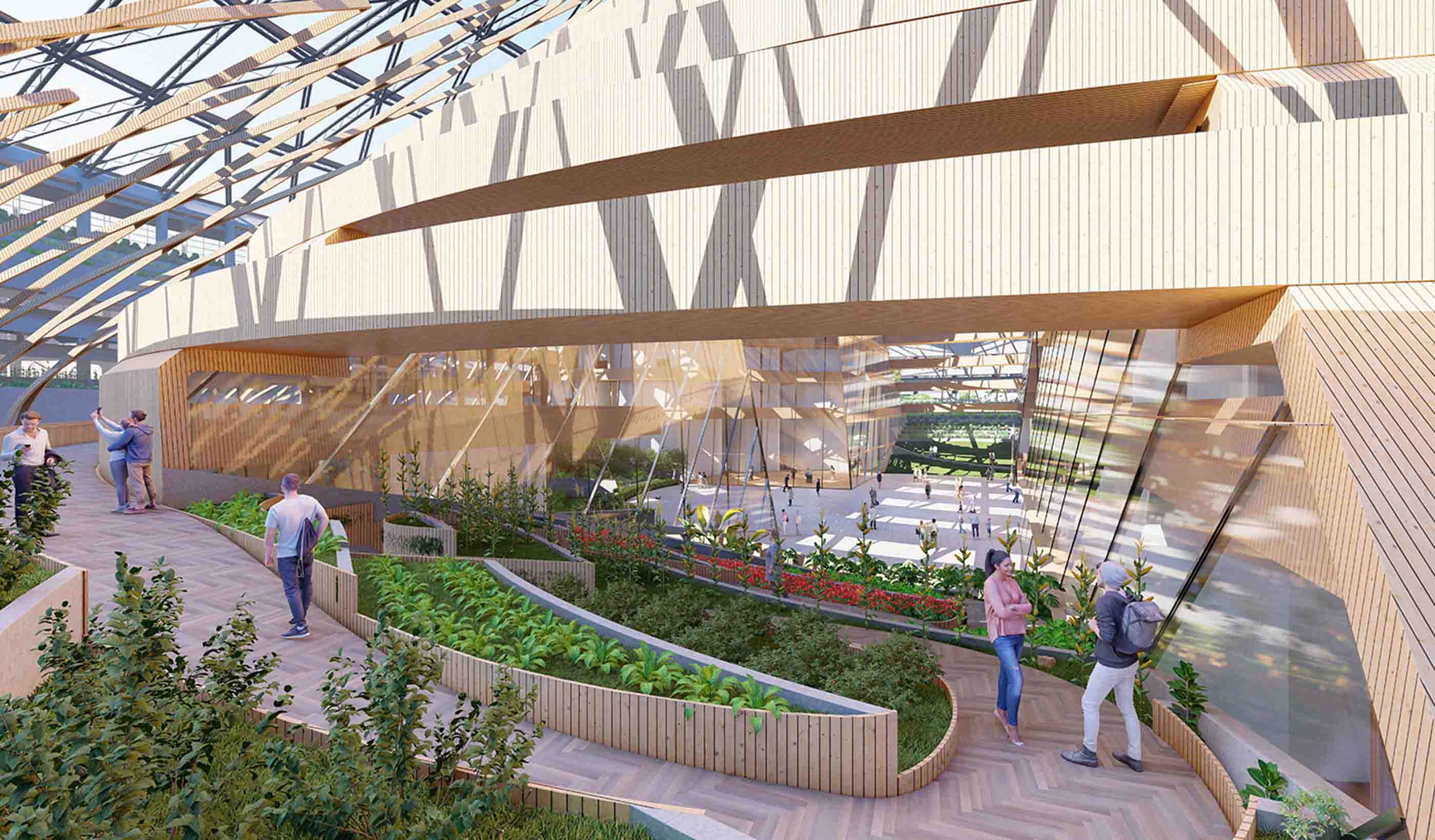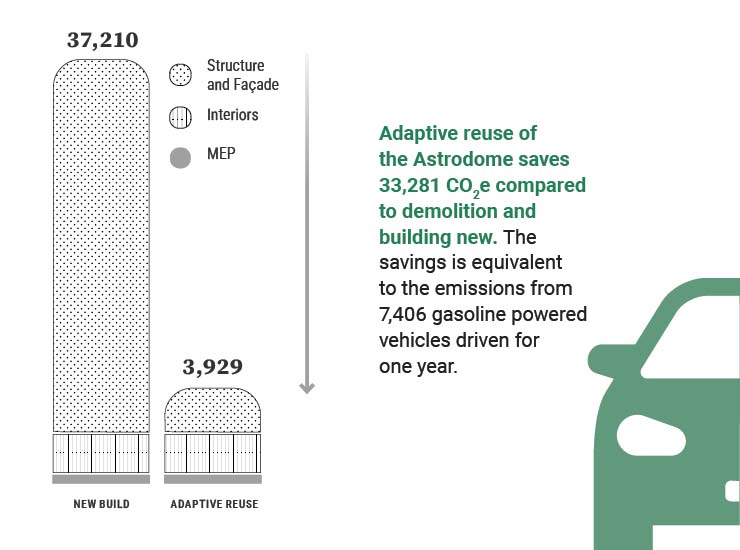6 big net zero design ideas for a Houston Astrodome renovation
July 09, 2024
July 09, 2024
Design competition concept repurposes the iconic sports stadium as an agricultural center
A version of this article first appeared as “Grown in the Astrodome: Pushing the frontier of net zero design” in Design Quarterly Issue 21.
Is it time for a Houston Astrodome renovation? What if the Astrodome could be repurposed as a net zero agricultural center for a food-scarce area?
Competition projects stretch our design thinking, show what’s possible, and make room for innovation. They give us a chance to apply our designs, critical thinking, and collaboration to pressing issues facing society. They also give our designers a chance to collaborate across borders. ASHRAE—the organization that creates the standards for heating, cooling, and thermal comfort in buildings in the US—holds a LowDown Showdown competition every year. In 2023, the challenge was to repurpose the famed Houston Astrodome.
We envisioned a new purpose for Houston’s iconic Astrodome. We thought big but realistic.

The AgriDome Concept reuse of the Houston Astrodome in Texas. The design features a mass timber lattice structure (left) and sun-tracking photovoltaic array on the green space (right).
A design product of the space age, the Astrodome represented an optimistic vision for architectural innovation when it opened in 1965. It was the world’s first multipurpose domed sports stadium. Its state-of-the-art systems could air condition 1 million square feet of total floor area. But it has been closed since 2008.
Excited by the scale of the challenge, our team—the CO2 Crew—embarked on a mission: to craft an efficient structure that harmonized the stadium with its surrounding communities. We called our vision for the net zero community the AgriDome. Our design repurposes the domed stadium into a terraced urban farm, featuring an education center and a community farmers market on site. It also has new low-carbon residential buildings. Our design for the competition reminds us how we can think big about design and execute innovative projects. We’ve streamlined our approach to six ideas that drove our design and can be applied to any project.
When we looked closely at the neighborhood around the Astrodome, we saw a variety of needs that inspired us. In the area near the Astrodome, food security, affordable housing, and transportation are major issues. The site sits atop one of Southern Houston’s largest food deserts. There are 500,000 homes that are more than a mile away from a sustainable source of healthy food. We looked for solutions to increase the overall resiliency of this community. Knowing that produce travels a long way in the US, we looked at programming the space to reduce food miles and increase access to fresh produce. That led us to look at the possibility of a large urban farm.
We created a radial grid plan for a Houston Astrodome renovation that extends the building’s powerful geometry so that its major axes connect to public transit and the interstate to the east and south. A landscaped promenade flanked by commercial high streets extends along each axis at the parking level and around the Astrodome. We had a vision for the entire site, not just the building. So, we designed a new lively residential neighborhood on top of the existing surface parking lot with high-performance zero-carbon buildings, green space, and access to active and public transit.

Part of our design team’s decision-making process for the LowDown Showdown was the food challenges for those who live near the Houston Astrodome. There are 500,000 homes that are more than a mile away from a sustainable source of healthy food.
The repurposed Astrodome can make a difference in social equity and wellness. It will offer healthy food, jobs, and housing in an area that needs all three.
We gave the Astrodome new identities as a terraced urban farm, an education center, and a community farmers market. Each becomes a community asset. The urban farm gives the community access to fresh sustainable produce. We opened 4.5 acres of farmland by repurposing the stadium as an agricultural facility. In addition to traditional forms of farming, we added zip-grow towers that quadruple the yield. We carved out spaces for learning, sustainable community development, and commerce. The area features classrooms, research and exhibition spaces, a library, bike storage, two theaters, a café, and a restaurant. These amenities are all contained within a pyramid shape, which lines up with some of Houston’s prominent landmarks.
The public plaza at the heart of the education center acts as a community hub activated by a farmers’ market and cultural events.
Flooding is a major issue here. Houston has been called America’s rainfall-flooding capital. Our project and its community require water. And it was a prime consideration. What kind of strategies can we employ to prevent flooding, conserve and use rainwater, and irrigate the farm?
Our design for the competition reminds us how we can think big about design and execute innovative projects.
To make the new neighborhood flood resilient, we raised it on a plinth above the existing parking lot. We incorporated rain gardens and green roofs to filter stormwater and porous pavement areas to mitigate stormwater runoff. We proposed an integrated rainwater runoff system to recover rainwater and store it for flushing, farming, and irrigation. We calculated rainfall against the time of use to optimize the sizing of the storage tank. The rainwater and gray water recovery and storage system will reduce the community’s annual freshwater use by 96 percent.
Inside the Astrodome, our grow towers greatly increase the volume of food the farm can produce. And the misting they require creates beneficial microclimates. Additionally, these grow towers offer shade and cooling while improving air quality.
The greenest building is the one that’s already built. The same goes for a Houston Astrodome renovation. In our reuse of the existing large-scale structure, we avoided huge, embodied carbon emissions associated with demolition and building new.
We chose low-carbon mass timber for our primary structure and specified lower-carbon concrete and recycled steel for construction. And we looked at Carbon Cure technology and a mycelium-based product as a low-carbon alternative to geofoam for insulation. We used lightweight recycled foamed glass aggregate in our landscape design. Why? Because it has a high recycled content and adds little to structural load requirements. We cut our CO2e by 33,281 tCO2e with these strategies, a 98 percent reduction. We optimized building envelopes and glazing. And to make the buildings more efficient we chose high-performance displacement ventilation systems.

The AgriDome Concept for the LowDown Showdown competition repurposes the domed stadium into a terraced urban farm. It also features an education center and a community farmers market on site.
We designed this reuse project as a 100 percent electric building. So, we needed to decrease energy use. We used borehole thermal storage. Photovoltaics (PV) on the Astrodome windows and in the surrounding greenspace generate on-site renewable energy. The PV array reduces carbon emissions from operations by approximately 803 tCO2e per year, achieving net zero carbon. By raising the carbon-neutral concrete plinth we lowered the heat-island effect created by the vast sea of asphalt parking.
We took a pragmatic approach to our design solutions. We chose materials available in the US. We also picked highly efficient, off-the-shelf mechanical and electrical systems. Our high-level cost analysis shows this proposal is buildable. In this way, our Houston Astrodome renovation shows what is possible in community development and building reuse.
We used technology to help our design process. Using parametric design applications, we created more than 100 possible design iterations. We considered external wall insulation, glass thermal and optical performance, horizontal shade depth and distance, and ventilation mode (hybrid vs. full air conditioned). In evaluating our designs, we looked at energy use intensity, daylight autonomy, discomfort glare risk, and indoor thermal comfort in evaluating designs. Many of the ideas that we explored didn’t fit, of course. But the abandoned ideas are just as important as the ones we used. They may work on a different project. We looked at creating thermal comfort through natural ventilation, but its minimal impact on energy use didn’t justify its cost and complexity. We examined using high-efficiency glass but found that a louver system to provide shading on the pyramid was a better value. We thought about incorporating wind generation and sail turbines. In the end, we couldn’t justify it.

In our adaptive reuse of the existing large-scale Astrodome, our design avoided huge, embodied carbon emissions associated with demolition and building new.
Competitions can be exercises in imagination. They explore concepts that may never get built. The question is, how can we make that fantasy a reality? In this case, we’re already taking what we learned from the LowDown Showdown idea and applying it to real buildings that we’re designing.
We recently brought in some of the engineering innovations applied on the Astrodome competition entry (including borehole thermal storage) to a project in Boulder, Colorado, with stringent low-carbon requirements. So, our Houston Astrodome renovation project itself may never take flight. But the innovative approaches to net zero design we employed will live on in the next generation of our designs.
The Stantec CO2 Crew won second place and the fan-favorite category at the 2023 ASHRAE LowDown Showdown. Stantec's Lowdown Showdown Team, The CO2 Crew included Michael Banman, Bradley Cowan, Amir Firoozi, Ben Javate, William Ketcham, Russell Lavitt, Anders Macgregor, Daniel Massaro, Samira Zare Mohazabieh, Corey Leb, Chinmayee Patil, Aaditya Patel, Aditya Potipireddi, Kat Polischuk, Peter Sharma, and Amir Tabadkani.